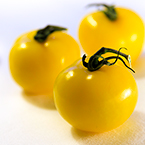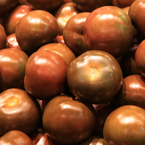Tomato
French botanist Tournefort provided the Latin botanical name, Lycopersicon esculentum, to the tomato. It translates to "wolfpeach" -- peach because it was round and luscious and wolf because it was erroneously considered poisonous. The botanist mistakenly took the tomato for the wolfpeach referred to by Galen in his third century writings, ie., poison in a palatable package which was used to destroy wolves.
The English word tomato comes from the Spanish tomatl, first appearing in print in 1595. A member of the deadly nightshade family, tomatoes were erroneously thought to be poisonous (although the leaves are poisonous) by Europeans who were suspicious of their bright, shiny fruit. Native versions were small, like cherry tomatoes, and most likely yellow rather than red.
The tomato is native to western South America and Central America. In 1519, Cortez discovered tomatoes growing in Montezuma's gardens and brought seeds back to Europe where they were planted as ornamental curiosities, but not eaten.
Most likely the first variety to reach Europe was yellow in color, since in Spain and Italy they were known as pomi d'oro, meaning yellow apples. Italy was the first to embrace and cultivate the tomato outside South America.
The French referred to the tomato as pommes d'amour, or love apples, as they thought them to have stimulating aphrodisiacal properties.
In 1897, soup mogul Joseph Campbell came out with condensed tomato soup, a move that set the company on the road to wealth as well as further endearing the tomato to the general public.
Campbell may have made tomato soup popular, but the first recipe is credited to Maria Parloa whose 1872 book The Appledore Cook Book describes her tomato chowder.
The high acidic content of the tomato makes it a prime candidate for canning, which is one of the main reasons the tomato was canned more than any other fruit or vegetable by the end of the nineteenth century.
(Source: About.com)
|












